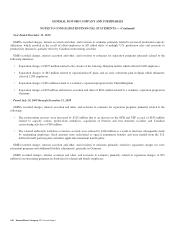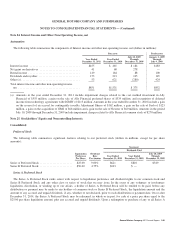General Motors 2011 Annual Report Download - page 177
Download and view the complete annual report
Please find page 177 of the 2011 General Motors annual report below. You can navigate through the pages in the report by either clicking on the pages listed below, or by using the keyword search tool below to find specific information within the annual report.GENERAL MOTORS COMPANY AND SUBSIDIARIES
NOTES TO CONSOLIDATED FINANCIAL STATEMENTS — (Continued)
GM
Year Ended December 31, 2011
We applied the two-class method to calculate basic earnings per share and the more dilutive of the two-class or the if-converted
method to calculate diluted earnings per share. Under the two-class method for computing earnings per share, undistributed earnings
are allocated to common stock and the Series B Preferred Stock according to their respective participation rights in undistributed
earnings, as if all the earnings for the period had been distributed. This allocation to the Series B Preferred Stock holders reduced Net
income attributable to common stockholders, resulting in a lower basic and dilutive earnings per share amount. Variability may result
in our calculation of earnings per share from period to period depending on whether the application of the two-class method is
required. Refer to Note 25 for a description of the Series B Preferred Stock and the application of the two-class method.
The application of the two-class method resulted in an allocation of undistributed earnings to our Series B Preferred Stock holders
and, accordingly, 152 million common stock equivalents from the assumed conversion of the Series B Preferred Stock are not
considered outstanding for purposes of determining the weighted-average common shares outstanding in the computation of diluted
earnings per share.
MLC distributed all of its 272 million warrants for our common stock to its unsecured creditors and the GUC Trust. The warrant
holders may exercise the warrants at any time prior to their respective expiration dates. Upon exercise of the warrants the shares
issued will be included in the number of basic shares outstanding used in the computation of earnings per share.
Warrants to purchase 313 million shares of our common stock were outstanding at December 31, 2011, of which 46 million shares
were not included in the computation of diluted earnings per share because the warrants’ exercise price was greater than the average
market price of the common shares. Under the treasury stock method, the assumed exercise of the remaining warrants resulted in
130 million dilutive shares.
Diluted earnings per share included the effect of 13 million unvested RSUs granted to certain global executives. The Adjustment
Shares were excluded from the computation of basic and diluted earnings per share as the condition that would result in the issuance
of the Adjustment Shares was not satisfied.
In July 2011 the 61 million shares of common stock contributed to our pension plans in January 2011 met the criteria to qualify as
plan assets for accounting purposes. These shares were considered outstanding for earnings per share purposes beginning in July
2011.
Year Ended December 31, 2010
Warrants to purchase 318 million shares of our common stock were outstanding, of which 46 million shares were not included in
the computation of diluted earnings per share because the warrants’ exercise price was greater than the average market price of our
common stock. Under the treasury stock method, the assumed exercise of warrants to purchase the remaining warrants resulted in
106 million dilutive shares.
Diluted earnings per share included the effect of 11 million unvested RSUs granted to certain global executives. The dilutive effect
of the RSUs was included only for the period subsequent to our public offering as the RSUs prior were accounted for as liability
awards prior to that date. The Adjustment Shares were excluded from the computation of basic and diluted earnings per share as the
condition that would result in the issuance of the Adjustment Shares was not satisfied.
Period July 10, 2009 through December 31, 2009
Outstanding warrants to purchase 272 million shares of common stock were not included in the computation of diluted loss per
share because the effect would have been antidilutive and 1 million RSUs were excluded from the computation of diluted loss per
share as these awards were payable in cash during that time. The Adjustment Shares were excluded from the computation of basic and
diluted loss per share as the condition that would result in the issuance of the Adjustment Shares was not satisfied.
General Motors Company 2011 Annual Report 175
























